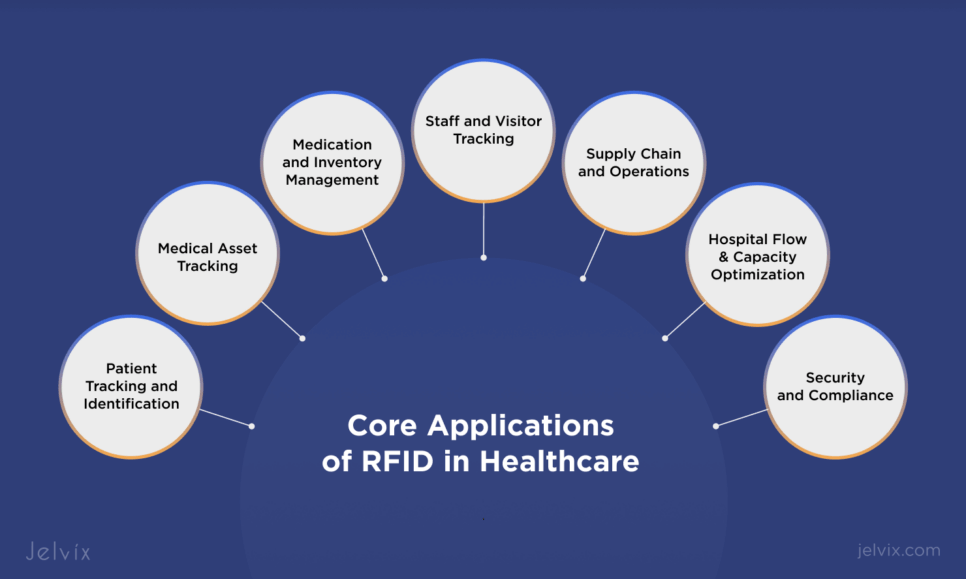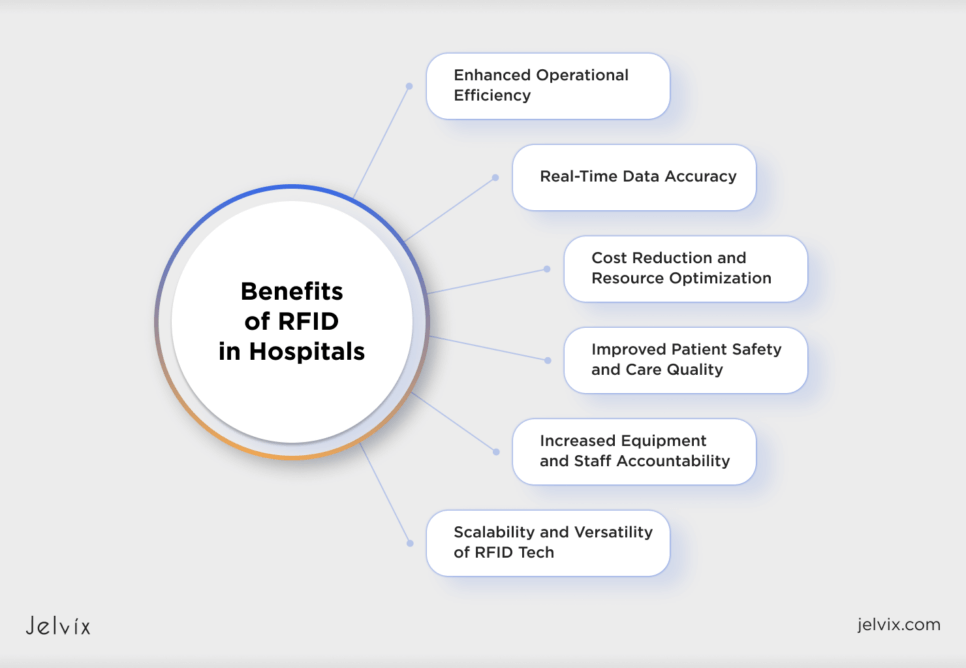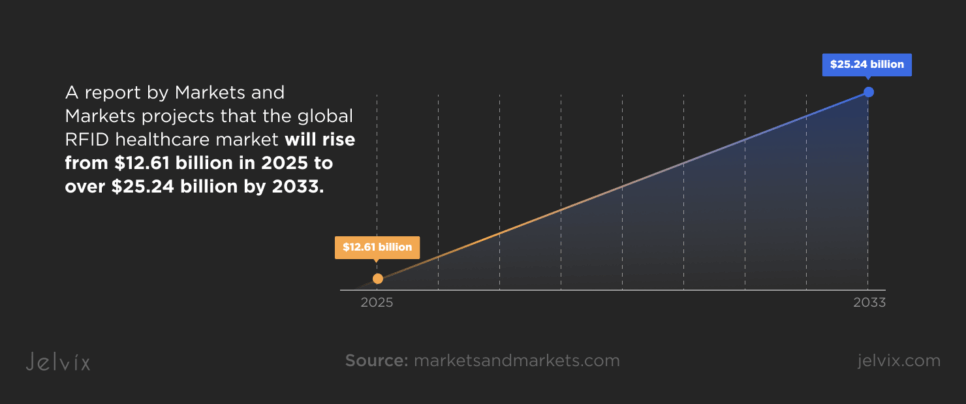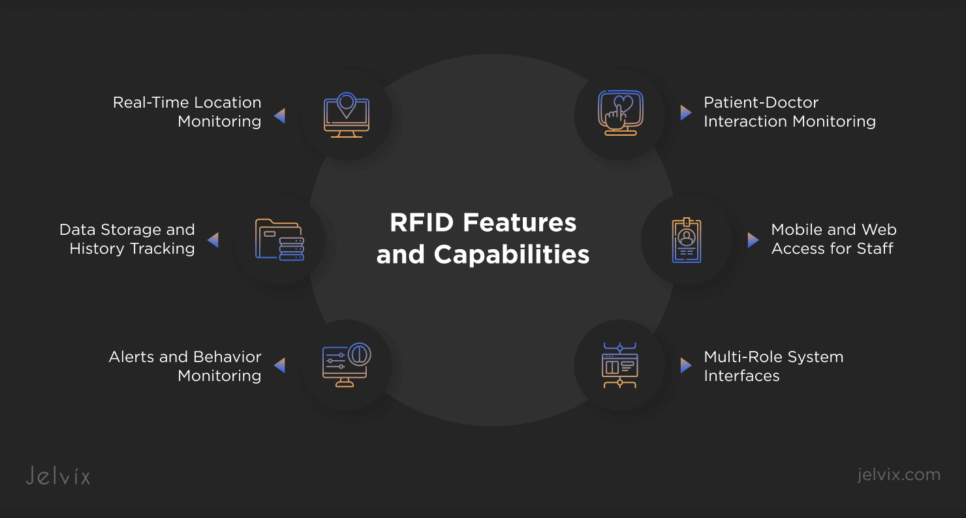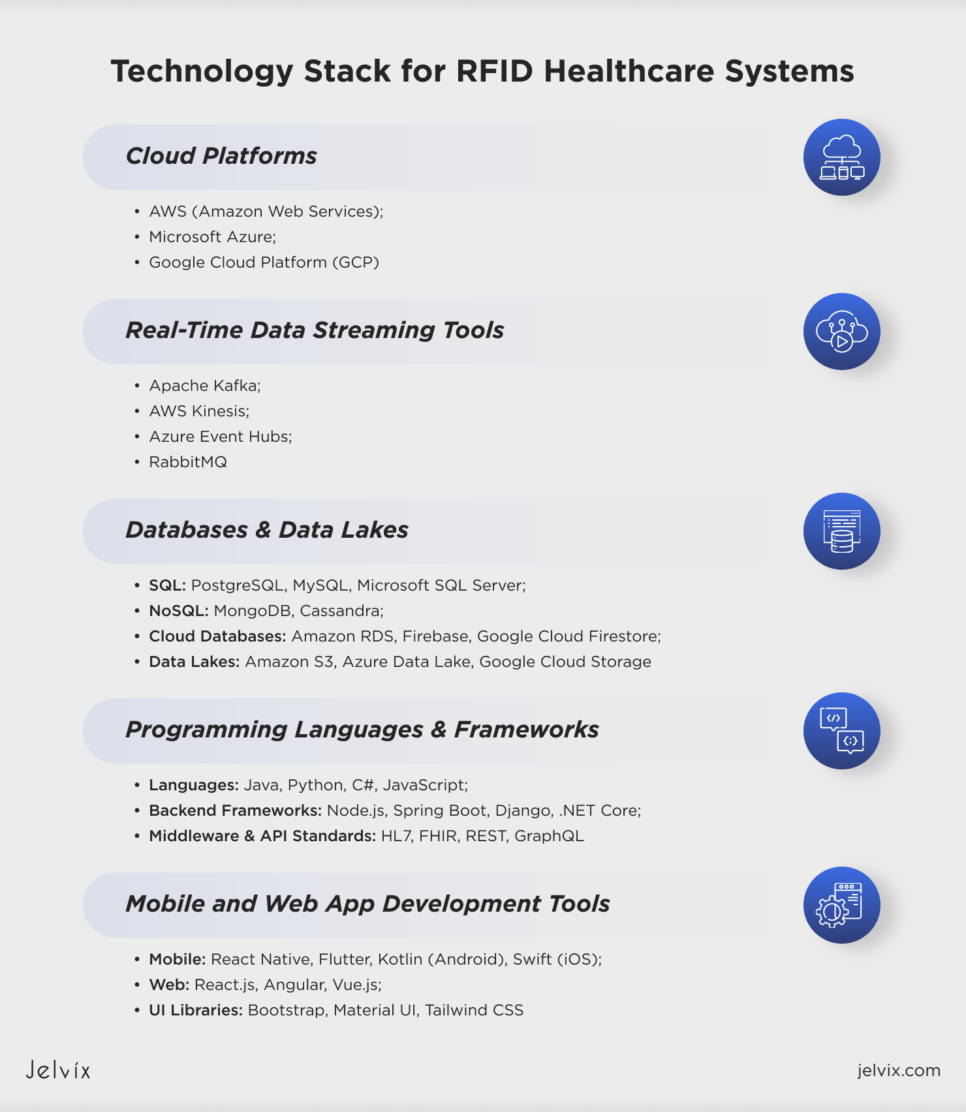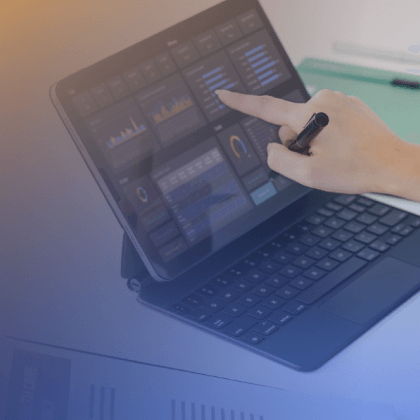Radio Frequency Identification (RFID) is a wireless technology that uses electromagnetic fields to automatically detect and track tagged objects. Originally presented in industrial environments, RFID has developed into a fundamental component of real-time data systems in industries from retail to transportation, and most importantly, healthcare.
Any RFID tracking system is really based on a synergy between three core components: the tag, the reader, and the supporting software infrastructure. Usually no more than a grain of rice, the tag uses wireless communication upon electromagnetic field activation from an RFID reader and carries identification information.
This reader compiles the tag’s contents and forwards it to middleware—programs designed to filter and mix with corporate systems or hospital databases. RFID makes it very easy to keep track of things like surgical equipment, drug kits, and staff badges by arranging this digital handshake.
Silent in the background in medical environments, RFID reduces the margin for human error and increases operational visibility. Without compromising clinical focus, these technologies create a dynamic, self-auditing environment that points up anomalies, enhances emergency responsiveness, and accelerates regular chores.
The worldwide RFID healthcare industry is developing fast as the need for automation and traceability in patient care increases. Deep weaknesses in asset monitoring and people coordination exposed by the COVID-19 epidemic spurred this change. Hospitals were using RFID to confirm test kit and PPE authenticity but also to keep control over overflowing inventory and increased patient traffic.
Since then, drug companies have introduced RFID-tagged injectables, while logistics companies provide pre-tagged supplies for easy incorporation into current hospital systems. Regulatory systems have also changed; currently, drug distribution and packaging must show more exact traceability.
In this context, RFID is turning from a futuristic add-on into a layer of crucial infrastructure for contemporary, responsive, and responsible healthcare delivery.
Core Applications of RFID in Healthcare
Patient Tracking and Identification
Patient tracking and identification is one of the most transformative RFID uses in medical environments. Designed to go well beyond simple ID wristbands, RFID patient tracking systems offer a real-time view of patient location, movement, and treatment milestones across the hospital ecosystem. An RFID-enabled wristband becomes an active data point from the time a patient checks in, guaranteeing that every given prescription, diagnostic test, or surgical intervention is exactly matched to that particular patient.
In neonatal units, these systems offer a crucial safeguard against mix-ups by linking newborns to their mothers and designated care teams through matched tags. The same approach supports geriatric care, where patients with cognitive impairments often require close monitoring. Without compromising patient dignity or independence, RFID offers a non-intrusive means to monitor movements, identify boundary violations, and prompt alerts.
Particularly in trauma centers or large-scale public health responses, RFID technology serves as a force multiplier in emergency situations. By immediately updating patient locations and treatment statuses, it allows fast triage and dynamic reassignment of medical professionals even in scenarios when patients cannot communicate. These features create a digital safety net against procedural mistakes and improve operational clarity.
Medical Asset Tracking
Knowing exactly where important instruments are at any one point can help to improve patient care in hospitals where equipment is always moving. For instance, a defibrillator used in an emergency can be found right away, even if it was left outside a recovery area or transported without appropriate handoff. This guarantees that the necessary tools are always ready and helps staff members find them with less time consumed.
RFID hospital asset tracking also helps to better understand the usage of equipment. The system gathers information on device locations, frequency of use, and idle times, as well as device lifetime. Armed with this knowledge, hospitals can identify trends, like those of machinery kept unused in one department but highly sought after in another. These insights let managers determine whether to rent fewer backups, shift equipment, or fix devices before they fail.
Preventing loss is yet another big benefit. Devices can be transported to the incorrect floor, lost, or even stolen in crowded spaces. By informing the system when a tagged object passes a restricted area or leaves the facility, RFID adds a layer of quiet protection. Although staff members’ extra effort is not necessary for this type of automatic monitoring, it nonetheless safeguards priceless machinery and maintains seamless operations.
Medication and Inventory Management
Medication management in hospitals is a high-stakes task. Through real-time visibility of inventory data, RFID assists in reducing multiple risks. Every tool becomes part of a live system, tracking its whereabouts, use, and state of condition. Should a batch of medication approach its expiration date, the system can inform you before it goes bad. Early alerts guarantee that only safe, current medication gets to patients and help save waste.
More broadly, RFID for hospitals helps in handling inventory overall. As things pass several locations, the system automatically changes stock levels instead of depending on manual counts or barcode scans. Without stopping processes, this automation helps to keep correct records. It also avoids typical problems, including running out of highly sought-after pharmaceuticals during peak hours or overstocking low-use drugs.
Medication distribution also quietly but importantly relies on RFID. When a nurse scans a patient’s RFID tag alongside a tagged medication, the system cross-checks the information to confirm it’s the right drug, dose, and time. This lessens the probability of human mistakes, particularly in busy departments like oncology or critical care, or during shift changes.
Staff and Visitor Tracking
Managing the flow of staff and visitors within a hospital is a logistical challenge that directly impacts care quality. Visibility into movement patterns provided by RFID tracking enables managers to identify locations of inefficacious transitions between clinical areas or points of delay. RFID data can highlight problems if a care team regularly arrives late to a given wing or if portable equipment lags behind patient transfers. The hospital can then react by changing the paths of assignment or reorganizing that slow down treatment.
Knowing who is where in the facility is not a luxury—that is a need during an emergency. Healthcare RFID enables staff members to be quickly located in case a fire starts in the basement or if a code is called on an upper level. Security personnel can coordinate evacuations faster. Emergency teams can head directly to the zone that needs immediate support, even if radios fail or the environment becomes chaotic.
Another absolutely vital role is controlling access to high-risk areas. Some locations, including isolation units or drug storage rooms, call for rigorous restrictions on who visits. Based on a person’s clearance level or job, RFID-enabled badges can either automatically grant or deny access. This shields patients, stops policy violations, and lessens the need for hand-held ID checks or keypads that might be forgotten or bypassed.
Supply Chain and Operations
Hospital supply chains are complex and often difficult to monitor in real time. By tracking items individually as they arrive, pass through departments, or are utilized during care, RFID gives this process structure. Staff members can find a cargo missing or delayed right away without depending on phone calls or paper logs.
RFID reduces data input errors and delays by eliminating manual steps from inventory control. The system refreshes stock levels without staff scanning or recording each change; it logs item movement automatically. This offers a real-time, accurate picture of what is on hand as well as what has to be refilled.
Better tracking results in less overstocking and fewer emergency orders. Rather than basing purchases on estimates, hospitals might change them depending on real use. RFID reduces waste, stops shortages, and enhances supply room, procurement team, and care unit collaboration.
Hospital Flow & Capacity Optimization
Delayed interdepartmental communication sometimes throws off hospital operations. By tracking real data on how people and resources move across the facility, RFID closes that gap. With every update, the system creates a real-time view independent of manual status boards or verbal check-ins.
When a patient is ready to be moved, but no bed seems readily available, the problem is usually not a real shortage—rather, it is the lack of consistent view. RFID lets personnel know whether rooms that have just been emptied or flagged for cleaning are available for use once more. That communication speed makes faster admissions and more seamless stages of care transfers possible.
When patient numbers vary unevenly throughout the hospital, workload pressure develops rapidly. While some wings are still unused, others start to back up. RFID data shows the load inequalities before they become gridlock. Enough lead time allows coordinators to move resources or reroute fresh arrivals to balance the system.
Security and Compliance
Security breaches in healthcare rarely announce themselves—they develop quietly, often hidden behind small oversights or missing logs. Through automatic tracking of who accessed what, when, and where, RFID enhances medical system integrity. Every transaction leaves a digital trail, which makes it more difficult for illegal behavior to go unnoticed.
Compliance calls for reliable, time-stamped documentation that auditors could rely on, not only a checklist. This is produced automatically in part by RFID. The technology creates a safe record in the background without depending on staff to remember and record every incident.
RFID can set out a real-time alarm when something odd happens, say, access to a restricted room outside of business hours. Security teams have the opportunity to act right away on such a signal. These technologies assist healthcare providers in establishing compliance, analyzing events, and creating a culture where traceability is the standard rather than an afterthought.
Benefits of RFID in Hospitals
RFID technology in healthcare offers more than just convenience. It actively reshapes how hospitals operate, monitor, and deliver care across departments.
Enhanced Operational Efficiency
Hospitals that implement RFID for healthcare workflows often report major gains in speed and coordination. In a pilot program at the University of California, San Francisco Medical Center, RFID tags on surgical instruments reduced the average case cart assembly time, significantly accelerating surgical preparation and room turnover. This direct impact on time-sensitive tasks highlights the role of healthcare RFID systems in streamlining operations where delays can ripple across the day’s procedures.
Real-Time Data Accuracy
A delay in updating patient or inventory data in dynamic care settings might lead to cascade problems. By entering real-time location and status data into hospital information systems, RFID in medical facilities lowers certain risks. For example, research carried out in a Romanian clinic showed the application of an IoT and RFID system to track patient movements, which improved the facility’s patient flow monitoring. This ongoing exchange of information helps to coordinate different care units and avoid bottlenecks.
Cost Reduction and Resource Optimization
By improving inventory control and reducing waste, RFID for healthcare environments can result in notable cost reductions. Through real-time tracking and automated inventory systems, hospitals have reported, for instance, fewer losses from expired drugs and more effective use of expensive medical instruments. These advancements not only help to save unnecessary expenditures but also guarantee that important medical supplies are always available, improving general operational effectiveness.
Improved Patient Safety and Care Quality
Especially during high-risk operations, patient safety depends on repeatable, verified actions. By including identification, tracking, and verification right into surgical processes, RFID technology in healthcare supports these steps. Using RFID in operating rooms raised patient identification verification rates from 75% before deployment to 100% afterward, according to a 2011 Ku et al. study.
This change cut the danger of incorrect patient interventions and removed uncertainty during prep. The same study also saw improved safety procedure compliance as physician time-out completion rates rose from 43% to 70%. An often disregarded but important problem in sterile conditions, instrument loss, dropped from 0.146% to 0.089%.
These findings reveal that RFID medical equipment creates a safer, more responsible care environment, utilizing automation supporting clinical accuracy under pressure, transcending mere activity.
Increased Equipment and Staff Accountability
Maintaining responsibility for equipment and staff movement is absolutely vital in hectic hospital settings. Real-time tracking of medical devices and workers made possible by healthcare RFID guarantees that equipment is always available as needed and that staff mobility is precisely recorded.
For example, Hull University Teaching Hospitals NHS Trust in the UK used RFID to track over 70,000 assets, including syringe pumps and nebulisers, saving staff members’ previously large, time-consuming search efforts. Through accurate location data, RFID systems improve operational efficiency and ensure staff members and equipment are used wisely.
Scalability and Versatility of RFID Tech
RFID technology distinguishes itself in healthcare by being able to scale over several environments and application cases. From multi-site hospital systems to local clinics, RFID adapts to meet changing needs.
Driven by the growing demand for inventory automation, patient tracking, and regulatory compliance solutions, a report by Markets and Markets projects that the global RFID healthcare market will rise from $12.61 billion in 2025 to over $25.24 billion by 2033. As hospitals install medical device RFID systems in several departments, the technology shows adaptability enough to enable new procedures without distressing current systems.
RFID Features and Capabilities
Healthcare RFID solutions provide precision, speed, and control in environments where time and accuracy matter. Their core features support daily hospital functions without adding extra steps for staff.
Real-Time Location Monitoring
RFID tags update patient, staff, or equipment locations as they move. This reduces time lost searching for tools and helps manage room readiness more effectively. Real-time visibility in crowded departments helps to avoid delays brought on by untracked patient movement or lost assets.
Data Storage and History Tracking
Every scanned event is kept on file. When hospitals examine regular breaks in use or audit resource allocation, that data becomes invaluable. Staff members may precisely track exactly where a device was or how long it stayed idle, rather than depending on memory or logs.
Alerts and Behavior Monitoring
When anything odd occurs—like a bed entering a prohibited zone or a medication cart left in a hallway—systems can set off automated alarms. These alarms help to keep control over sensitive areas and procedures and speed up responses.
Patient-Doctor Interaction Monitoring
RFID helps to verify whether rounds were finished or care procedures followed by recording staff entry and exits from patient rooms. It generates a timestamped layer of monitoring that doesn’t interrupt the workflow.
Mobile and Web Access for Staff
Most RFID systems include mobile apps or dashboards available via browsers. Staff members may thus verify device locations, bed status, or supply levels without returning to a workstation or calling another department.
Multi-Role System Interfaces
Different views of the same data are needed by security teams, doctors, and managers. RFID systems let this separation take place. All under the same system, administrators control operations, care teams handle flow, and security guards watch sensitive zones.
In healthcare, RFID serves purposes beyond only infrastructure. This subtle yet dependable system ensures consistency, increases responsibility, and helps hospitals run free from more blind spots. The technology keeps extending what hospitals can measure, control, and trust as features grow more integrated.
RFID Software Architecture in Healthcare
An RFID in healthcare typically consists of physical RFID readers, RFID tags, antennas, edge devices, middleware, and cloud infrastructure for data processing and storage.
RFID Readers and Tag Communication:
RFID tags (passive, active, or semi-passive) emit data when activated by readers. Readers use specific radio frequency bands (typically UHF 860–960 MHz for healthcare applications) to collect tag data. Readers can be fixed (e.g., at doorways) or mobile (e.g., handheld scanners). Antennas facilitate signal transmission and reception. The tag ID, timestamp, and reader location are captured and sent upstream for processing.
Edge Gateways, Cloud Gateways, and Firewalls:
Readers push data to local edge gateways, which perform initial processing (e.g., filtering redundant reads, timestamp normalization). This data is encrypted and transmitted over secure channels (TLS/SSL) to cloud gateways. Firewalls and intrusion detection systems protect this transit, enforcing hospital security policies (e.g., HIPAA compliance in the U.S., GDPR in Europe).
Data Lakes and Big Data Warehouses:
Raw RFID data is ingested into a data lake (often in formats like JSON or Parquet). It is then processed and transformed into structured formats for querying, typically in a relational data warehouse (e.g., Snowflake, Google BigQuery, or AWS Redshift). This supports batch and real-time analytics workflows.
Surely, RFID hospital management tools make no sense if they are not integrated into the existing workflow. The RFID middleware layer or integration platform (e.g., Apache Kafka, HL7/FHIR APIs, Mirth Connect) synchronizes RFID events with hospital enterprise systems:
- EHR Systems (e.g., Epic, Cerner);
- ERP Systems (e.g., SAP, Oracle);
- CMMS (Computerized Maintenance Management Systems).
And finally, for all info gathered and systemized to be usable, RFID technologies use dashboards and other visual elements. RFID data is visualized by using BI platforms like Tableau, Power BI, or custom dashboards built with frameworks such as React.js or Angular. Dashboards typically include:
- Real-time asset heatmaps and occupancy indicators;
- Patient movement tracking timelines;
- Inventory usage and replenishment cycle charts;
- Compliance alert logs (e.g., unauthorized access events, missed equipment handoffs)
Analytics layers may also include predictive modeling (using ML frameworks like TensorFlow or PyTorch) for tasks like bed availability forecasting or procedure time estimation, leveraging historical RFID tag behavior.
Technology Stack for RFID Healthcare Systems
Reliable and scalable RFID solutions in healthcare software development call for a strong and modular tech stack. From data collecting to visualization, every layer—including sensitive patient data handling—must run in real time and safely connect with current hospital systems. Below is a typical technology stack used in modern RFID healthcare deployments.
Cloud Platforms
- AWS (Amazon Web Services);
- Microsoft Azure;
- Google Cloud Platform (GCP).
Real-Time Data Streaming Tools
- Apache Kafka;
- AWS Kinesis;
- Azure Event Hubs;
- RabbitMQ.
Databases & Data Lakes
- SQL: PostgreSQL, MySQL, Microsoft SQL Server;
- NoSQL: MongoDB, Cassandra;
- Cloud Databases: Amazon RDS, Firebase, Google Cloud Firestore;
- Data Lakes: Amazon S3, Azure Data Lake, Google Cloud Storage.
Programming Languages & Frameworks
- Languages: Java, Python, C#, JavaScript;
- Backend Frameworks: Node.js, Spring Boot, Django, .NET Core;
- Middleware & API Standards: HL7, FHIR, REST, GraphQL.
Mobile and Web App Development Tools
- Mobile: React Native, Flutter, Kotlin (Android), Swift (iOS);
- Web: React.js, Angular, Vue.js;
- UI Libraries: Bootstrap, Material UI, Tailwind CSS.
This stack guarantees that real-time processing, safe data interchange, and responsive interfaces fit various tasks. RFID solutions may scale with hospital needs and integrate easily into clinical processes by integrating proven cloud software development technologies with healthcare-specific middleware and adaptable front-end tools.
Implementation Examples and Case Studies
RFID has been applied to maximize instrument monitoring and management in surgical settings. For example, a case study at Copenhagen’s Rigshospitalet showed that using an RFID surgical equipment monitoring system might save around 31,000 hours yearly in operating room procedures.
The technology guaranteed precise counts before and after operations by allowing automatic identification and recording of surgical tray contents, minimizing the chance of retained surgical objects and so improving patient safety.
RFID has been used in mental health facilities to track staff and patient movements, improving compliance and safety.
For example, staff members and patients in a behavioral health network used an IoT solution via which they wore RFID-enabled bracelets. By sending real-time location data to a cloud server, these gadgets allow for constant monitoring and quick alarms should patients reach restricted regions. The system can also be linked with the electronic health records of the hospital to offer a whole picture of patient interactions and movements.
RFID also has been used to enhance appointment scheduling and wellbeing. Tracking patient flow and wait times helps medical professionals maximize scheduling, clear overload, and improve the patient experience generally. Real-time information on patient whereabouts and appointment statuses helps staff members make decisions based on real-time data, guaranteeing prompt delivery of treatment and effective use of resources.
Read more about the role of the app development companies in medical diagnostics.
Challenges and Solutions in RFID Adoption
Using RFID in healthcare brings operational benefits but not without certain difficulties. Data security is among the most delicate problems there are. RFID sends data wirelessly, hence improper encryption or segmenting of systems runs the natural danger of illegal interception. Depending on their region, hospitals that combine RFID with EHR systems have to make sure tag transmissions and recorded identities satisfy HIPAA or GDPR criteria.
Still another recurrent problem is hardware loss. Often, tags affixed to low-cost items like linens or food trays are lost or thrown away during daily operations. These absent tags can accumulate in both cost and confusion over time. Some hospitals have responded by using washable RFID tags buried right into clothing or equipment covers, reducing the possibility of inadvertent disposal and promoting tag reuse.
Another difficulty is interference, especially in settings heavy in metal, electronic devices, or fluid-filled containers. In radiology labs, for instance, signal distortion from imaging machines or lead-lined walls might reduce tag readability. Engineers sometimes move readers, utilize higher-gain antennas, or switch to special UHF tags made for metal surfaces to fix problems.
Environmental conditions can compromise performance even with appropriate infrastructure. Extreme temperatures, strong cleaning agents, or repeated sterilizing processes can all cause RFID tags to wear out faster than predicted. Several manufacturers today create medical-grade tags designated for high-cycle sterilization or chemical exposure to handle this. They are routinely used in sterile supply chains and ORs where durability is non-negotiable.
Although any one of these challenges can slow down implementation, none are insurmountable. Hospitals that design with both IT and clinical teams at the table often foresee these problems early on and modify their plans. What first seems to be a restriction over time turns into a wiser, more robust infrastructure component.
RFID in Healthcare: Pricing Estimates
Knowing the cost of RFID deployment in hospitals calls for assessing the system’s scope, integration complexity, and long-term value rather than only computing hardware. The degree of RFID integration into daily operations and the system customizing to a facility’s requirements will affect costs.
Software scope is among the most powerful cost drivers. Less development work will be required for a lightweight solution tracking simply high-value assets than for a system combined with EHR, ERP, and compliance monitoring dashboards. Custom development usually costs more upfront than off-the-shelf systems, especially when APIs and middleware must interact across several platforms. But off-the-shelf systems also have restrictions that might call for costly solutions later on.
Though not always easier to control, equipment expenses are more predictable. Purchased in bulk, passive RFID tags might cost as little as $0.10 per unit; active tags with sensors or integrated batteries might run more than $20 apiece. Depending on range and capability, readers start around $500 for handheld devices and can run up to $2,000 for high-frequency fixed equipment. Especially in older facilities, infrastructure improvements—such as shielded server enclosures, embedded wall readers, or ceiling-mounted antennas—also affect cost.
Once put into use, operational expenses turn toward system maintenance, technical support, and software hosting. Most cloud-based RFID systems charge by tiered use, per device, per data transaction. Especially when RFID is included in hospital-wide analytics or real-time dashboards, monthly service prices sometimes rise with data volume. System updates, security patches, and compliance audits are ongoing necessities, especially in environments subject to regulatory review.
Many hospitals find a good return on RFID systems within 18 to 36 months, even with the original outlay. Reduced equipment loss, improved inventory control, fewer administrative hours, and averted regulatory fines translate into savings. Sometimes, enhanced asset visibility lets hospitals completely postpone or cancel big procurement orders.
Designed for scale, RFID becomes not only a tracking tool but also a cost-control mechanism that sharpens decision-making and guards margins.
The Smart Way to Choose – Download Your Guide to Selecting the Right Healthcare Tech Partner!

Conclusion
Looking ahead, the demand for intelligent hospital systems will continue to grow. Healthcare companies are looking to find solutions that provide both speed and transparency as pressure to maximize resources, reduce waste, and keep regulatory compliance rises. RFID tracks this path closely.
RFID will tightly interact with EHRs, automation systems, and predictive analytics as interoperability criteria like FHIR develop, and edge computing is more reasonably priced. Once isolated, tracking capabilities will become part of connected ecosystems supporting real-time clinical decision assistance.
Jelvix can help you upgrade your hospital operations using scalable, intelligent RFID technologies. From IT consulting and proof of concept to entire enterprise deployment, our team designs, develops, and implements RFID solutions catered to your processes. Get in touch right now to discuss how our knowledge of healthcare technologies might produce quantifiable outcomes for your company!
FAQ
What is the RFID Tag in a hospital?
In a hospital, an RFID tag is a tiny electronic gadget that communicates with RFID readers via radio waves. Medical equipment, drug containers, staff ID badges, patient wristbands—all of them can be fastened with tags. Every tag stores important information that enables real-time tracking and monitoring of objects or people and bears a unique identification.
Is RFID secure for use in healthcare environments?
Yes, RFID technologies are safe for application in healthcare when correctly designed. Sensitive patient and hospital data is protected by encryption techniques, safe data transmission (using firewalls and cloud gateways), and role-based access controls. RFID tags also do not directly store personal health information; most data is referenced via secure backend services.
How does RFID Technology improve medication management?
Real-time drug supply level tracking, expiration date tracking, and consumption pattern tracking are made possible by RFID. This decreases loss from theft or misplacement, helps prevent administrative mistakes, and reduces the possibility of using outdated medications. Storing usage instructions and dose data connected to every tag guarantees compliance with safety procedures as well.
How does RFID enhance hospital asset management?
Hospitals can now fully see the whereabouts and use of medical equipment, thanks in part to RFID. It increases asset use, minimizes time spent tracking tools, and eliminates equipment loss. Automated maintenance and calibration reminders also help hospitals ensure that all equipment is safe and ready to use.
Can RFID compromise patient privacy?
Data privacy is something RFID systems are meant to account for. Usually, tags just have an identification value; they do not include comprehensive personal data. Every critical piece is kept on safe servers and accessed via encrypted connections. To further patient privacy, hospitals also follow HIPAA and other data protection rules.
Need a qualified team of developers?
Reach top talent pool to handle end-to-end delivery of your project.


